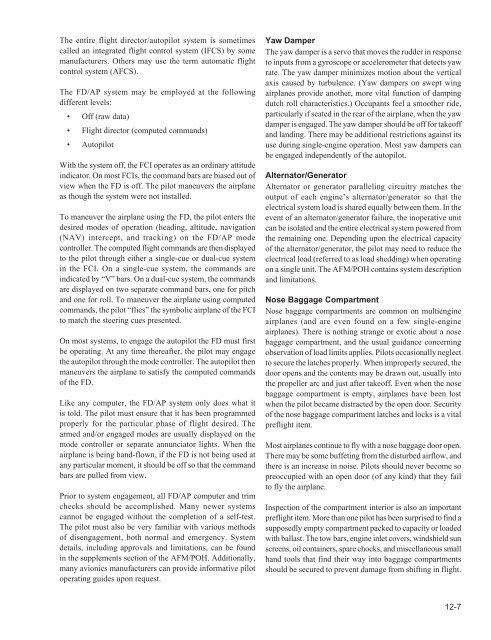You also want an ePaper? Increase the reach of your titles
YUMPU automatically turns print PDFs into web optimized ePapers that Google loves.
The entire flight director/autopilot system is sometimes<br />
called an integrated flight control system (IFCS) by some<br />
manufacturers. Others may use the term automatic flight<br />
control system (AFCS).<br />
The FD/AP system may be employed at the following<br />
different levels:<br />
• Off (raw data)<br />
• Flight director (computed commands)<br />
• Autopilot<br />
With the system off, the FCI operates as an ordinary attitude<br />
indicator. On most FCIs, the command bars are biased out of<br />
view when the FD is off. The pilot maneuvers the airplane<br />
as though the system were not installed.<br />
To maneuver the airplane using the FD, the pilot enters the<br />
desired modes of operation (heading, altitude, navigation<br />
(NAV) intercept, and tracking) on the FD/AP mode<br />
controller. The computed flight commands are then displayed<br />
to the pilot through either a single-cue or dual-cue system<br />
in the FCI. On a single-cue system, the commands are<br />
indicated by “V” bars. On a dual-cue system, the commands<br />
are displayed on two separate command bars, one for pitch<br />
and one for roll. To maneuver the airplane using computed<br />
commands, the pilot “flies” the symbolic airplane of the FCI<br />
to match the steering cues presented.<br />
On most systems, to engage the autopilot the FD must first<br />
be operating. At any time thereafter, the pilot may engage<br />
the autopilot through the mode controller. The autopilot then<br />
maneuvers the airplane to satisfy the computed commands<br />
of the FD.<br />
Like any computer, the FD/AP system only does what it<br />
is told. The pilot must ensure that it has been programmed<br />
properly for the particular phase of flight desired. The<br />
armed and/or engaged modes are usually displayed on the<br />
mode controller or separate annunciator lights. When the<br />
airplane is being hand-flown, if the FD is not being used at<br />
any particular moment, it should be off so that the command<br />
bars are pulled from view.<br />
Prior to system engagement, all FD/AP computer and trim<br />
checks should be accomplished. Many newer systems<br />
cannot be engaged without the completion of a self-test.<br />
The pilot must also be very familiar with various methods<br />
of disengagement, both normal and emergency. System<br />
details, including approvals and limitations, can be found<br />
in the supplements section of the AFM/POH. Additionally,<br />
many avionics manufacturers can provide informative pilot<br />
operating guides upon request.<br />
Yaw Damper<br />
The yaw damper is a servo that moves the rudder in response<br />
to inputs from a gyroscope or accelerometer that detects yaw<br />
rate. The yaw damper minimizes motion about the vertical<br />
axis caused by turbulence. (Yaw dampers on swept wing<br />
airplanes provide another, more vital function of damping<br />
dutch roll characteristics.) Occupants feel a smoother ride,<br />
particularly if seated in the rear of the airplane, when the yaw<br />
damper is engaged. The yaw damper should be off for takeoff<br />
and landing. There may be additional restrictions against its<br />
use during single-engine operation. Most yaw dampers can<br />
be engaged independently of the autopilot.<br />
Alternator/Generator<br />
Alternator or generator paralleling circuitry matches the<br />
output of each engine’s alternator/generator so that the<br />
electrical system load is shared equally between them. In the<br />
event of an alternator/generator failure, the inoperative unit<br />
can be isolated and the entire electrical system powered from<br />
the remaining one. Depending upon the electrical capacity<br />
of the alternator/generator, the pilot may need to reduce the<br />
electrical load (referred to as load shedding) when operating<br />
on a single unit. The AFM/POH contains system description<br />
and limitations.<br />
Nose Baggage Compartment<br />
Nose baggage compartments are common on multiengine<br />
airplanes (and are even found on a few single-engine<br />
airplanes). There is nothing strange or exotic about a nose<br />
baggage compartment, and the usual guidance concerning<br />
observation of load limits applies. Pilots occasionally neglect<br />
to secure the latches properly. When improperly secured, the<br />
door opens and the contents may be drawn out, usually into<br />
the propeller arc and just after takeoff. Even when the nose<br />
baggage compartment is empty, airplanes have been lost<br />
when the pilot became distracted by the open door. Security<br />
of the nose baggage compartment latches and locks is a vital<br />
preflight item.<br />
Most airplanes continue to fly with a nose baggage door open.<br />
There may be some buffeting from the disturbed airflow, and<br />
there is an increase in noise. Pilots should never become so<br />
preoccupied with an open door (of any kind) that they fail<br />
to fly the airplane.<br />
Inspection of the compartment interior is also an important<br />
preflight item. More than one pilot has been surprised to find a<br />
supposedly empty compartment packed to capacity or loaded<br />
with ballast. The tow bars, engine inlet covers, windshield sun<br />
screens, oil containers, spare chocks, and miscellaneous small<br />
hand tools that find their way into baggage compartments<br />
should be secured to prevent damage from shifting in flight.<br />
12-7


